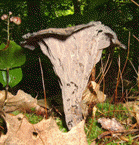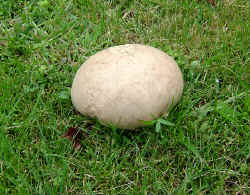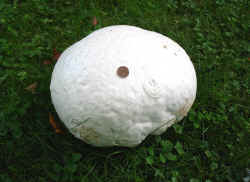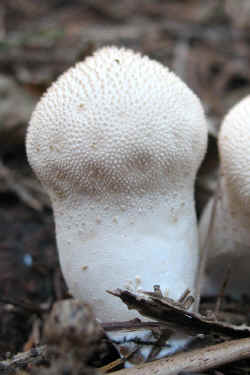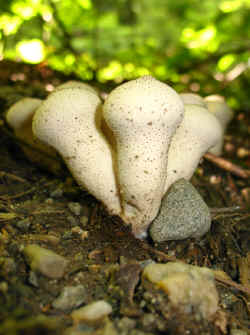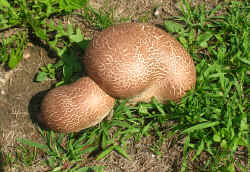|
|
A New England and Eastern Canada Edible and Medicinal Mushroom Resource |
||||||||
|
Puffballs A puffball was the first wild mushroom I ever tried in the summer of 1973. I had heard of a rule about puffballs while at a party held by my art professor. In attendance were vegetarians, phrenologists, foot reflexologists and the like. It was explained to me that if you slice through a puffball and it is pure white, it will be good to eat. Later that summer, I found a giant puffball (Calvatia gigantea) in the yard at the house of a college friend where I, and a bunch of crazy hippy friends who were celebrating the end of our senior year that summer, were having a cookout. I was three months late graduating. Duh. It was big and nice and after a beer or three, I started liking the idea of eating it extra special well. At the time, I couldn't cook my way out of a paper bag so I cooked it in a crappy frying pan on an open fire in the back yard where we were also burning some hamburgers, buns, and other stuff so I, and a few brave or drunk friends, ate that mushroom as poorly as I cooked it. In spite of eating it with severely burnt hamburgers and washing it all down with four dollar a case beer we all survived reasonably well (except for the hangover). White all the way through is a very good rule but it should have a couple of corollaries. It is best if the puffball is larger than your fist. Make sure you do not see the pattern of a developing capped mushroom on the interior after you cut it. You could die from eating an amanita button. To be safe it is best to stick with the large puffballs at first such as the giant puffball (Calvatia gigantea) and the purple-spored puffball, also occasionally known as the vase puffball, (Calvatia cyathiformis) if you are a beginner. These are big. Usually they are larger than an orange or a grapefruit and often dramatically larger. The largest puffball ever found was close to 4 feet across and close to 50 lbs! Fruit body Large hemispherical fruit whitish or brownish color occasionally found in groups or fairy rings. Stem (stipe) Calvatia gigantea has no stem but string-like attachments to the ground. Calvatia cyathiformis has a cup-shaped base firmly attached to the ground. Clavatia gigantea will roll easily and there will be very little dirt when you harvest it. Calvatia cyathiformis is likely to be broadly attached and have a fair amount of dirt on it. Flesh Fresh edible examples of either species will have white or whitish soft flesh all the way through. They must be white all the way through to be edible. Giant puffballs that show yellow to yellowish green interior are past their prime and should not be eaten. Purple-spored Puffball will turn yellowish purple to purple when past it's prime and should not be eaten. Most all puffballs are somewhat soft, like cutting into a loaf of bread. Not dense. If it is very dense, look closely to see if there is an immature mushroom cap developing. If yes, throw it away immediately! Spores Calvatia cyathiformis has purplish spores as it's name would suggest. Calvatia gigantea has brownish spores. When and where to find them Giant Puffballs are found on lawns, fields, field edges and occasionally under hardwoods usually in late spring or fall. Purple-spored Puffballs are found mostly on lawns or pastures or in very old cemeteries. Preparation These are a nice flavored mushrooms. It can be a dilemma to find one because they can be so large and require fairly immediate preparation. Using a bread knife and slicing them to bread-like thickness or slightly thinner is a good approach. Sautéing/pan frying or tempura frying is the best way to go. I have not tried drying. Cooking puffballs in the sauté pan is a lot like cooking eggplant. They absorb a lot of oil so if you add too much oil or butter they will be soggy. Adding some garlic to the sauté pan is nice. I make little pizzas with them as the "dough" putting on sauce or salsa and cheese and other ingredients. They can be used instead of pasta for lasagna, or as a replacement for eggplant or tofu. Freeze them between sheets of plastic wrap for later use. Comments These are some of the easiest species to identify. Giant Puffballs the size of a soccer ball are not uncommon. They appear very quickly and are a surprise to see. One might easily imagine that a child lost his ball. Most puffballs are edible however, pigskin puffballs that have a black interior and should never be eaten. They are dense, tough skinned, and very black inside. They are seldom larger than a tennis ball. They are poison. You might consider throwing any puffballs that are past their prime out in your yard or woods insuring that the spores will distribute. With some luck you may get some in your yard. Using ammonia as a mordant, Calvatia gigantea can be used to dye textiles or paper to a red-brown color. Calvatia cyathiformis will yield a rust red color.
Find more information here: Calvatia
cyathiformis at AmericanMushrooms.com
Use of this site will constitute your acceptance of the disclaimer. Copyright 2011 Mushroom-Collecting.com. All rights reserved. |
||||||||
